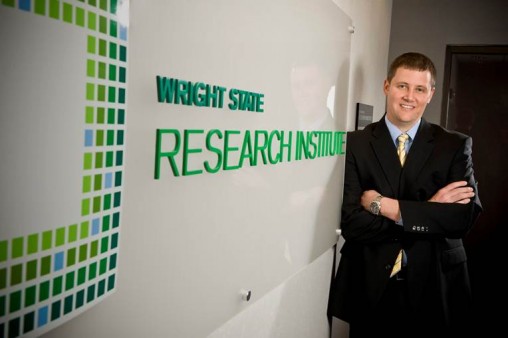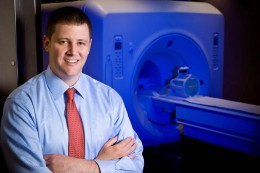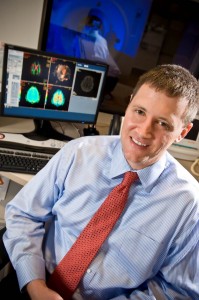
As the new director of the Wright State Research Institute, Jason Parker plans to lead WSRI through continued growth, while cultivating research talent.
The day Jason Parker agreed to become the new director of the Wright State Research Institute (WSRI), he also became a father. His wife delivered the couple’s first child following a frightening race to the hospital that had Parker thinking he may have to stop the car and deliver the baby himself.
His wife delivered a healthy baby boy just 20 minutes after making it to the hospital, following what Parker called “a wild ride.”
Today, just a few weeks later, Parker is focusing much of his attention on WSRI, taking the reins of an organization on a wild ride of its own.
In the six years since its inception, the research powerhouse has grown an explosive 550 percent, boasting a $20 million portfolio and nearly 70 scientists, engineers and other staff.
Sprawling through a Beavercreek facility near campus and directly across from Wright-Patterson Air Force Base, WSRI applies basic science to quickly address pressing, real-world problems. It serves as a gateway to expertise at Wright State University, marshaling resources from the university and elsewhere to solve problems ranging from combat fatigue to the operation of unmanned aerial vehicles.
“We have scientific expertise in house that is remarkable and a testament to the potential of the Dayton region,” Parker said. “We can also reach back into the Wright State University community, working with faculty and scientists to bring their research to defense and commercial sponsors.”
Parker, Ph.D., plans to lead WSRI through continued growth, while cultivating research talent.
“What we bring to the table is a customer-focused approach leveraging on research talent and near-term solutions,” he said. “I want to see us grow considerably. The goal is to double in size over the next five years.”
“WSRI is strategically positioned to work well with the military—as well as government and industry—because it has strong ties to the installation,” said Robert Fyffe, Ph.D., Wright State’s vice president for research and graduate studies.
The institute can offer the resources of a major university, but with the speed of a defense contractor.
“We’re going to be able to create solutions for our clients, as well as help grow the research profile of the university and bring more research dollars into the university to support staff, to support faculty, to support students,” Parker said.
A scientist used to new frontiers

Jason Parker joined WSRI in 2012 as a medical physicist to lead its Neuroscience and Medical Imaging program.
Parker had always dreamed of becoming a medical researcher who would make discoveries that have an impact on medicine and help the sick. After finding his depth in math and science at Manatee Community College, Parker went to Rensselaer Polytechnic Institute in Troy, N.Y., the nation’s oldest technological university. There he obtained his bachelor’s degree in applied physics with a focus on the medical applications of physics.
Parker was well on his way to becoming an expert in medical imaging, the use of radiation to create images inside the body that can be used to diagnose disease and treat it. In obtaining his Ph.D. at the University of Florida, Parker wrote a dissertation on using new technologies to get a better view of the heart.
“There are a lot of challenges in creating detailed images of an organ that is in constant motion,” Parker said. “Our work was successful at creating snapshots of the heart at different stages of the cardiac cycle with greatly reduced motion blur.”
But after moving to Ohio in 2008, and working as the senior scientist for Kettering Health Network, Parker quickly began focusing on the brain, “the most complex and fascinating organ in the body,” he said. By strengthening understanding of the brain, researchers and doctors hope to develop methods to combat debilitating brain diseases such as Alzheimer’s, “while also creating opportunities to expand the function and capabilities of the healthy brain,” he said.
At Kettering, Parker grew a new, interdisciplinary translational research initiative focused on developing and applying emerging imaging techniques to improve the treatment of disease. While his imaging work involved monitoring how cancer tumors were affecting brain function and assessing the progress of the disease, Parker knew the future was in finding new applications for the technology.
Parker soon began talking with the Air Force Research Laboratory at Wright-Patterson about how imaging the brain could be used to study human performance.
“There was a part of me that was interested in the entrepreneurial aspects of the science and making sure that the work scientists do is applied in a real-world setting,” he said.
And that is when he met the Wright State Research Institute.
In 2010 he found the “ideal collaborator” in WSRI, he said, and agreed to author a proposal for a five-year, $5 million neuroscience imaging program for AFRL aimed at using imaging techniques to map the brain and study augmentation methods to improve the effectiveness of the warfighter.
“I knew Wright State had a lot of capability to tap, and WSRI was flexible in pulling it together,” he said. “The model really worked.”
Parker had done previous research for the government on how sleep deprivation affects human cognition, especially in the areas of attention and working memory. Using magnetic resonance imaging, or MRI, Parker partnered with researchers at AFRL and other organizations to perform studies on how basic functional and chemical properties of the brain were related to the negative effects of fatigue on the brain. The research found that while lack of sleep causes loss of cognitive ability and performance for most people, there are some people in which it doesn’t, and that those people tend to have a different brain activity pattern from the rest of us.
“Those are the people you want flying your planes and unmanned vehicles and making decisions when you have a major conflict that’s going on for a long period of time, and they haven’t slept for 30 hours,” Parker said.
After winning the contract, WSRI hired Parker in early 2012 as a medical physicist to lead its Neuroscience and Medical Imaging program, which it sees as its largest growth area.
Customers and commercialization

Under Jason Parker's leadership, WSRI is developing partnerships to take technology out of the research and development stage and into industry.
A solid scientist, Parker is also keenly aware of the need to focus on clients.
“Dr. Parker’s foundation is in science, but he brings business aspirations to the institute that make it clear he really understands how to translate entrepreneurial spirit into action,” said Wright State University Provost S. Narayanan, Ph.D., P.E.
Parker grew up in a Sarasota, Fla., where the tourism industry surrounding that beach community taught him the importance of a service-oriented culture.
“The livelihoods of most of us there hinged on serving the needs of customers—real estate, retail, food service,” said Parker, who spent many years in the restaurant industry and whose parents both worked in real estate. That’s an important value he says defines his approach to business.
“We’re going to grow our defense contracting activities by staying committed to creating quality solutions for our customers, while expanding our collaboration with the state and other government agencies,” he said.
But in thinking of new frontiers for WSRI, and “how we’re going to be positioned to play in the world 30 years from now,” WSRI’s biggest opportunity is in commercializing research, Parker said.
WSRI is developing partnerships to take technology out of the research and development stage and into industry, much like an incubator.
“Here in the Dayton region and throughout Ohio, we have great infrastructure to do this and really boost the economy,” he said.
On the job, Parker plans to create excitement around WSRI’s activities, cultivate talented employees and help its researchers understand how important their work is to medicine and the nation’s defense.
“I’m really excited about the future of WSRI,” Parker said. “The last five years have laid a foundation for the institute in research and development that we intend to leverage and build upon. The capabilities, infrastructure and, most importantly, people are all in place to position our organization for another five years of explosive growth.”

 Wright State partners with local universities, hospitals to expand mental health care for students
Wright State partners with local universities, hospitals to expand mental health care for students  Wright State students, first responders team up for Halloween event
Wright State students, first responders team up for Halloween event  Explore Wright State Day welcomes hundreds of future Raiders
Explore Wright State Day welcomes hundreds of future Raiders  Four Wright State nursing programs receive accreditations, including new doctorate degree
Four Wright State nursing programs receive accreditations, including new doctorate degree  Wall Street Journal ranks Wright State top public university in Ohio for student experience
Wall Street Journal ranks Wright State top public university in Ohio for student experience 